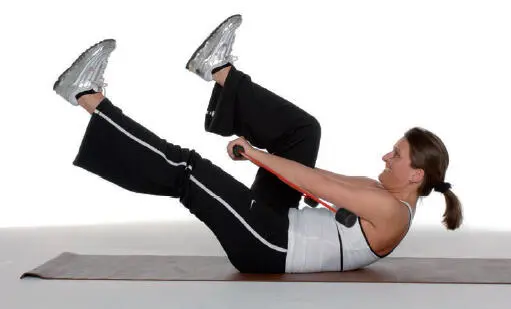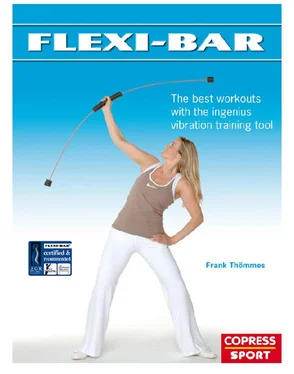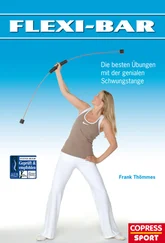Different Frequencies of Base Plates and Dynamic Bars Different Frequences of Base Plates and Dynamic Bars Partly, the effects of swinging subsoils and swinging bars differentiate enormously, especially when the dynamic bar must be set swinging and is not externally controlled. The main difference lies in the coordination of movement here, because the impulse to bring a dynamic bar to vibrate has to be controlled arbitrarily. For externally controlled base plates or attached vibration devices this is not the case. Vibrating base plates additionally swing with considerably higher frequences than dynamic bars. Through improper use, this involves risks for one’s health. Thus, there is no unrestricted recommendation for externally controlled vibration exercise. The theoretical framework of the effect of low frequences of about 5 Hz (swingings per second) is justified in the system of the postural ontogeny (cf. p. 21). Practically, this means that these frequences favour the reflexive, active erection of the muscles close to the spinal column, and therefore develop their stabilising effect intersegmentally (between the individual segments of the vertebras, which means between the vertebral body and the small neighbouring vertebral joints). In the therapeutic practice, surprising successes in therapy seem to be possible. Vibrations above 10 Hz produce multiplied stretching reflexes in the muscular system. Over reflex arcs, this then leads to tightness in the muscles, which otherwise is only caused by exercise. The latter, not in such a high frequency though. There is an increased ability to tense the muscles and, thus, an increased tension of the muscle base at the bone, which can theoretically increase the strength of the bone and should stimulate its stabilisation tendencies. All in all, however, are the therapeutic as well as the athletic effects only verified in individual cases and need further scientific support. Although it is a fact that it is often the case in the field of back problems that successes in therapy are not sufficiently supported by science, it does not cut down their administration or spread.
The Beginning of Dynamic Bars The Beginning of Dynamic Bars In the 60s already, Russian researchers experimented to retain their muscle strength and bone stability like astronauts under weightless circumstances without any bigger equipment. As a result, they had forms of exercising, in which external vibrations played an immense role. In 1991, physical therapist Bruce Hymanson invented a medium-long, flat swinging blade, the »Bodyblade,« in the USA. The therapeutic motivation behind his efforts, and the invention as a result to that, was the ability to go through a neuro-muscular exercise with an injured shoulder, without having to take painful exercise amplitudes to the damaged joint: a goal he reached with the »Bodyblade,« which one swings by hand. In the USA, however, the Bodyblade is only a moderately known exercise device. In about the mid 90s in Germany, shortly after that, therapeutic research results on patients were the basis of the idea of dynamic bars. These studies reported about diagnostic possibilities and exercise effects on patients, caused by swinging subsoils and swinging objects. However, a more specific distinction regarding the swinging objects did not take place. The therapeutic effect (a better balance, more strength in the erector spinae and better coordination) was comparable to classic spinal exercises. FLEXI-BAR group class at a sports club You can integrate the FLEXI BAR in varied ways into your workout program. Results of these researches, which by the way were ordered by the industry, were the »Posturomed« and the »Propriomed« – therapeutic exercise devices, which up to today are in use in almost every physical therapy office. However, they are in need of professional care and were not planned for private use. Before, the manufacturer already produced ergonomic seating furniture and devices to lay down on, which can support the swinging of the body, and can so develop health supporting effects. Henceforth, building up on this, the FLEXI-BAR and the »Stability Bar,« which still exists today under the term »Staby,« developed. Both devices consequently converted the available knowledge and therapy approaches with their development into something accessible for private users. All other forms of dynamic bars which entered the market afterwards and which still enter, can safely be called reproductions, trying to imitate the success of the FLEXI-BAR. These, however, offer no development work or any other support.
Effects of Vibration Exercise with Dynamic Bars 2 Effects of Vibration Exercise with Dynamic Bars
Simple Principle – Brilliant Effect
It All Swings
Training the Lower Back Muscles – Working with Reflexes
Segmental Muscles – Tension Inside the Spine
Quality Instead of Quantity
Core-Training – Stability of the Torso with the Dynamic Bar
Reduction of Weight with the FLEXI-BAR?
Biomechanical Foundations
Mode of Operation of Muscles During Swinging Exercise
The FLEXI-BAR-Concept
The Problem of Increasing Inactivity Due to Jobs in Front of Computers
Shortage of Time and Missing Stability
About the Product Development
Which FLEXI-BAR Is Suitable for Me?
The Best Exercises with the FLEXI-BAR
Risk of Injury?
Correct Warm-Up
To Bring the FLEXI-BAR to a Swinging
The Basic Position While Standing
Holding the FLEXI-BAR
Breathing and Concentration
Coordination and Redundancy
Intensity and Amplitude of Swinging
Combination with Other Devices
Music
Training with two FLEXI-BARS?
Indications and Contra-Indications
Dizziness During Swinging
Choice of Exercises and Determination of Intensity
Exercises for the Back
Basic
Advanced
Professional
Exercises for the Shoulders
Basic
Advanced
Professional
Osteoporosis-Training
Basic
Advanced
Professional
Exercises for the Pelvic Floor
Basic
Advanced
Professional
Exercises for Children
Basic
Exercises for Generation 60+
Basic
Advanced
Athletic Training
Basic
Advanced
Professional
Exercise at the Desk
Basic
Advanced
Professional


For more than 15 years, I have been working within the scope of by now over 1000 prevention classes with patients who seek professional help dealing with back problems. During my sports studies, I already got to know the complexity and the individual fates connected to it. In the course of my education in becoming one of Germany’s first teachers for back training and later as an instructor for the Forum Gesunder Rücken – besser leben e.V., I also became aware of the discrepancy between modern and seemingly out-of-date ways of therapy approaches for back problems.
Considering exercise as a measurement of all things when it comes to prevention and therapy of back pain, still has not been put into practice. After such a long time, it very well should be permitted to ask what the problem seems to be: even today I am still confronted over and over again with patients whose doctors only know about the therapy order of injection, pills and rest. Exercise is rarely recommended, and often it simply seems to be too late or too expensive to take deconditioning steps against the pain cycle through exercise therapy.
Читать дальше














